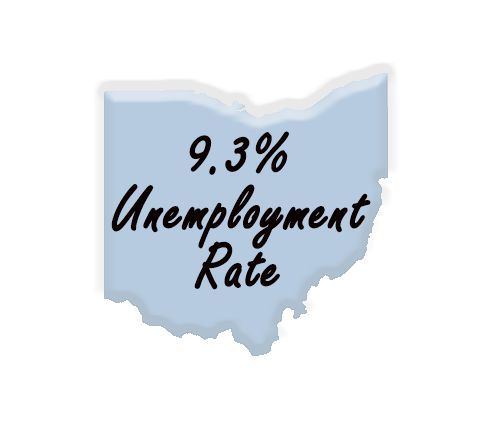Is Ohio’s Employment Revival as Good as the Unemployment Rate Indicates? Short Answer: No, Real Unemployment Rate Closer to 9.3%
By Matt A. Mayer
The most recent recession began in December 2007. In January 2008, the U.S. Bureau of Labor Statistics (BLS) listed Ohio’s unemployment rate at a low 5.7 percent.[1] BLS reported Ohio’s unemployment rate in August 2012 at 7.2 percent. This figure is 3.4 points less than the high reached in July 2009 when Ohio’s unemployment rate stood at 10.6 percent. This turnaround is quite impressive.
But, is this revival story entirely true? Though the state has seen marked improvement, the current unemployment rate overstates the recovery in Ohio because it fails to account for everyone who has been in the employment system in Ohio.
In January 2008, Ohio employed 5.61 million workers.[2] In July 2009, Ohio possessed just 5.31 million workers. By August 2012, Ohio’s job market had added 28,263 workers, hitting 5.34 million workers. That means Ohio needs to add another 276,232 jobs before “fully recovering” from the recession.
How did the unemployment rate improve so much? The answer is a shrinking labor force. From 2008 through August 2012, Ohio’s labor force lost more workers than every state except Michigan. From 2010 to August 2012, Ohio’s labor force lost more workers than every state. Ohio’s unemployment rate is being driven down by the shrinking labor force, not by job gains. The tables below details the facts:
Ohio
|
Date |
Labor Force |
Employed (All) |
Unemployed |
Unemployment Rate |
|
January 2008 |
5,950,610 |
5,614,143 |
336,467 |
5.7% |
|
July 2009 |
5,937,966 (-0.2%) |
5,309,648 |
628,318 |
10.6% |
|
August 2012 |
5,751,371 (-3.3%) |
5,337,911 |
413,460 |
7.2% |
Because Ohio’s labor force has dropped by 3.3 percent, the BLS unemployment rate makes the job market look healthier than it really is.
As Ohio only employed 28,263 more people since July 2009, the ranks of the unemployed dropped by 214,858. The reality is that many residents of Ohio have taken themselves out of the job market because they stopped looking for work. Another unquantifiable factor of labor force shrinkage is the small portion of residents who have left those states to join the labor forces in other states.
Out of all 50 states and the District of Columbia, Michigan and Ohio are the only states where the labor force decline exceeded the increase in the number of unemployed from January 2008 to August 2012. Not coincidentally, Michigan and Ohio experienced the worst private sector job market losses from 2000 to 2010.
Where Did Those Workers Go?
|
State |
Labor Force Decline 2008-2012 |
Increase in Number of Unemployed 2008-2012 |
Unaccounted for Workers |
|
Ohio |
-199,239 |
76,993 |
122,246 |
These two data points matter because neither the current labor force rate nor the current number of unemployed capture those individuals who used to be in the labor force. There are 122,246 workers in Ohio who remain unaccounted for in the current unemployment rates.
To properly account for those missing former workers, the unemployment rate calculation must include them. The BLS U4 unemployment rate measures “total unemployed plus discouraged workers, as a percent of the civilian labor force plus discouraged workers.”[3] See the table below for how the U4 rate misses the mark for Ohio.
U4 Rate Misses the Mark
|
State |
Labor Force |
U4 Rate |
U4 Raw Number |
Officially Unemployed |
U4 Discouraged Workers |
Unaccounted for Workers |
Where Are They? |
|
Ohio |
5,751,371 |
8.3% |
477,364 |
413,460 |
63,904 |
122,246 |
58,342 |
For Ohio, the U4 rate understates the real unemployment situation because it ignores 58,342 people. Here is what the numbers look like when the true unemployment rate is applied to the U4 calculation:
Revised U4 Rate Just About Right
|
State |
Labor Force |
U4 Rate |
U4 Raw Number |
Officially Unemployed |
U4 Discouraged Workers |
Unaccounted for Workers |
Where Are They? |
|
Ohio |
5,751,371 |
9.3% |
534,878 |
413,460 |
121,418 |
122,246 |
828 |
The punchline is that, when accounting for all the workers who are unemployed and who have left the labor force, the true unemployment rate in Ohio is most likely 9.3 percent. Failing to account for all the unemployed workers misrepresents how Ohio really is doing. We must make important choices in November on a wide range of issues—from who will be our President and our U.S. Senator to what local tax increases to support. Thus, having a clearer picture of how Ohio really is doing is critical.
[1] U.S. Bureau of Labor Statistics, Local Area Unemployment Statistics, Ohio Statewide, http://www.bls.gov/eag/eag.OH.htm, accessed September 22, 2012.
[2] U.S. Bureau of Labor Statistics, Economy at a Glance, Ohio Statewide Employment, http://www.bls.gov/eag/eag.OH.htm (accessed on July 31, 2012).
[3] U.S. Bureau of Labor Statistics, Local Area Unemployment Statistics, Alternative Measures of Labor Underutilization for States, http://www.bls.gov/lau/stalt.htm (accessed on July 31, 2012).

